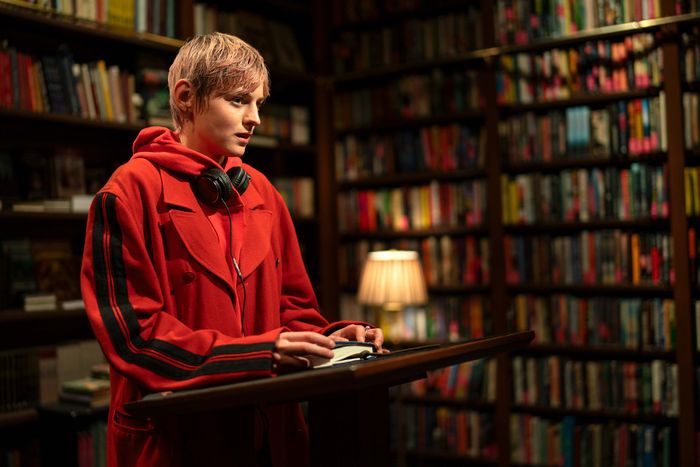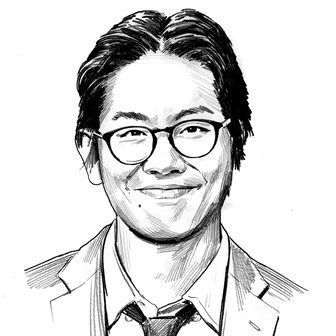
If you have even a passing familiarity with murder mysteries, then you probably know what’s going to happen in A Murder at the End of the World: A group convenes, someone dies, suspects emerge, and the heat is on the detective to find the killer. Thing is, FX’s new limited series barely works as a murder mystery. But in the hands of creators Brit Marling and Zal Batmanglij, this isn’t necessarily a critical problem. It may be even part of the appeal.
Consider it a matter of style. The duo’s works are known for a kind of extravagant weirdness. Their breakout Netflix series, The OA, can broadly be described as a supernatural mystery about a blind woman who returns after a several-year disappearance with her sight intact and an otherworldly belief that she’s meant to prevent a great tragedy. (Marling, who often stars in her own productions, plays the woman.) But the show was also expansive with the ideas it sought to pursue, touching upon the science of near-death experiences, the power of storytelling, parallel universes, and the simmering rage of wayward youth in a manner that didn’t feel too far from stream-of-consciousness freestyling. In its second season, The OA went on to blend genres in an effort to chase those ideas at a grander scale, shifting forms to take on elements of neo-noir and hard sci-fi. Marling and Batmanglij have an established interest in fusing high-minded ideas with matters of the bleeding heart, and much of the duo’s strange magic lies in their eagerness to warp storytelling shapes to fit that end. The effects are often wildly destabilizing, and for the right viewer, this can be a profound pleasure.
A Murder at the End of the World continues in the tradition. Protagonist Darby Hart (Emma Corrin) is a young amateur sleuth and hacker in the Lisbeth Salander mode who gets invited by a reclusive tech billionaire, Andy Ronson (Clive Owen), to participate in a symposium on the future of humanity at his remote bunker-resort in Iceland. In attendance is a small coterie of handpicked geniuses — a roboticist (Ryan J. Haddad), a smart-city expert (Joan Chen), an astronaut (Alice Braga), and so on — along with Ronson’s own staff and family, which includes his wife, Lee Andersen (Marling, characteristically ethereal), a hacker of some prominence who’s long disappeared from public view, and their inexplicably named young son Zoomer (Kellan Tetlow). Also in the mix is the sophisticated AI-assistant program that powers the compound, holographically personified as a gentle butler named Ray (Edoardo Ballerini).
This being a murder mystery, it isn’t long after the group gets together that someone dies, weather conditions begin to deteriorate around the compound, and Hart finds herself having to figure out what’s going on before the body count begins to multiply. This also being a Marling and Batmanglij show, though, there’s plenty else on its mind. The story in A Murder at the End of the World encompasses, among other things, true crime, Reddit sleuthing, trauma memoirs, climate change, artificial intelligence (generative and otherwise), hackers, anti-authoritarian art, and the extreme limits of capitalism. At one point, the characters are assembled to witness a swarm of robots hard at work manufacturing doomsday bunkers that double as Amangani-style resorts for the global elite.
If the Iceland narrative embodies A Murder at the End of the World’s high-mindedness, then its bleeding heart is located in a second parallel plotline. Alongside the murder mystery, we’re routinely pulled into a separate narrative that takes place in Hart’s past, presented to us out of order. There we learn that Hart grew up the child of a crime-scene coroner in a rural gothic milieu straight out of True Detective and eventually developed a keen interest in cold cases. (In some sense, we’re witnessing her foster “true-crime brain.”) While investigating the trail of a serial killer at large, she comes to meet fellow hacker and amateur sleuth Bill Farrah (Harris Dickinson) over the internet, and before long, they strike up a partnership that blossoms into romance as they work to track down the killer. Farrah turns out to be one of the guests at the symposium, having become sort of Banksy-esque artist in the intervening period, and a secondary mystery emerges as the show bounces between past and the present: What happened between Hart and Farrah? What did they find in their investigation? And how is he connected to Ronson, Andersen, and Zoomer?
It’s definitely a lot, and whether the show works for you ultimately depends on how you feel about the whole Marling-Batmanglij Experience. The duo’s sensibility — perhaps best described as what you get when you smash art-school pretension together with unbridled theater-kid sincerity — can be so self-seriously earnest as to be absurd, not to mention controversial: Recall that The OA’s first season culminated with a school shooting being averted by a group of people doing what is essentially interpretive dance, a choice that one critic described as “one of the most tasteless things I’ve seen a television show attempt in some time.” To those operating closer to Marling and Batmanglij’s wavelength, though, the results can feel thoroughly idiosyncratic and original, even brilliant.
In many ways, A Murder at the End of the World is an impressive narrative creation, grappling with artificial intelligence, the future of humanity, and where our souls might fit in with the whole thing. It’s visually striking, too; the Iceland scenes possess a moody, stylized aesthetic that’s always engaging to look at, and they’re pleasingly contrasted by the soft, orange-golden hues of the flashbacks. (Responsible for this are director of photography Charlotte Bruus Christensen and production designer Alex DiGerlando, the latter of whom, coincidentally, worked on True Detective.) However, it ends up adhering a little too closely to familiar murder mystery beats, which aren’t executed very well: The script does little to establish a cast of feasible suspects, the genre mechanics are bluntly executed, and the episodes quickly fall into a discernible rhythm of trying to guide our suspicions towards one character before clumsily shifting them with the next cliffhanger. This level of genre fidelity is both unexpected and unsuccessful, an unfortunate inversion of the Marling and Batmanglij method of twisting storytelling shapes to fit their own idiosyncratic impulses.
What you get, then, is something like a diet version of the Marling-Batmanglij Experience. This is, after all, a show that features meditations on the implications of artificial intelligence as well as an emotionally pivotal scene where someone says, “You want the killer to have meaning, but he doesn’t have meaning. I want to know how you feel” — the high mind and bleeding heart are both still equally present. But that signature destabilizing weirdness has gone missing, fundamentally limiting one of the core pleasures associated with the duo: a truly exciting sense of having no idea where all of this is going.


